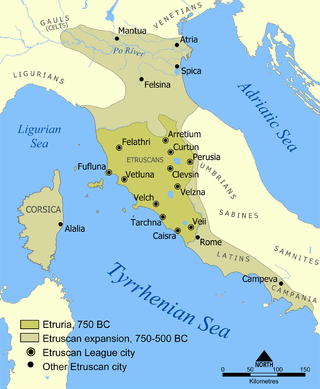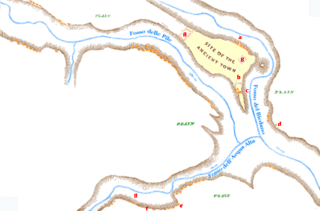
The Etruscan civilization was an ancient civilization created by the Etruscans, a people who inhabited Etruria in ancient Italy, with a common language and culture who formed a federation of city-states. After conquering adjacent lands, its territory covered, at its greatest extent, roughly what is now Tuscany, western Umbria, and northern Lazio, as well as what are now the Po Valley, Emilia-Romagna, south-eastern Lombardy, southern Veneto, and western Campania.

Corriere della Sera is an Italian daily newspaper published in Milan with an average circulation of 246,278 copies in May 2023. First published on 5 March 1876, Corriere della Sera is one of Italy's oldest newspapers and is Italy's most read newspaper. Its masthead has remained unchanged since its first edition in 1876. It reached a circulation of over 1 million under editor and co-owner Luigi Albertini between 1900 and 1925. He was a strong opponent of socialism, clericalism, and Giovanni Giolitti, who was willing to compromise with those forces during his time as prime minister of Italy. Albertini's opposition to the Italian fascist regime forced the other co-owners to oust him in 1925.

Etruscan religion comprises a set of stories, beliefs, and religious practices of the Etruscan civilization, heavily influenced by the mythology of ancient Greece, and sharing similarities with concurrent Roman mythology and religion. As the Etruscan civilization was gradually assimilated into the Roman Republic from the 4th century BC, the Etruscan religion and mythology were partially incorporated into ancient Roman culture, following the Roman tendency to absorb some of the local gods and customs of conquered lands. The first attestations of an Etruscan religion can be traced back to the Villanovan culture.

Arezzo is a city and comune in Italy and the capital of the province of the same name located in Tuscany. Arezzo is about 80 kilometres southeast of Florence at an elevation of 296 metres (971 ft) above sea level. As of 2022, the population was about 97,000.

The Pyrgi Tablets are three golden plates inscribed with a bilingual Phoenician–Etruscan dedicatory text. They are the oldest historical source documents from pre-Roman Italy and are rare examples of texts in these languages. They were discovered in 1964 during a series of excavations at the site of ancient Pyrgi, on the Tyrrhenian coast of Italy in Latium (Lazio). The text records the foundation of a temple and its dedication to the Phoenician goddess Astarte, who is identified with the Etruscan supreme goddess Uni in the Etruscan text. The temple's construction is attributed to Thefarie Velianas, ruler of the nearby city of Caere.

Volterra is a walled mountaintop town in the Tuscany region of Italy. Its history dates from before the 8th century BC and it has substantial structures from the Etruscan, Roman, and Medieval periods.

Indro Alessandro Raffaello Schizogene Montanelli was an Italian journalist, historian, and writer. He was one of the fifty World Press Freedom Heroes according to the International Press Institute. A volunteer for the Second Italo-Ethiopian War and an admirer of Benito Mussolini's dictatorship, Montanelli had a change of heart in 1943, and joined the liberal resistance group Giustizia e Libertà but was discovered and arrested along with his wife by Nazi authorities in 1944. Sentenced to death, he was able to flee to Switzerland the day before his scheduled execution by firing squad thanks to a secret service double agent.

Certaldo is a town and comune of Tuscany, Italy, in the Metropolitan City of Florence, in the middle of Valdelsa. It is about 35 kilometres (22 mi) southwest of the Florence Duomo.

Pyrgi was originally an ancient Etruscan town and port in Latium, central Italy, to the north-west of Caere. Its location is now occupied by the borough of Santa Severa. It is notable for the discovery here of the gold tablets, an exceptional epigraphic document with rare texts in Phoenician and Etruscan languages, and also the exceptional terracotta pediment statues from the temple.

San Casciano dei Bagni is a comune (municipality) in the Province of Siena in the Italian region of Tuscany, located about 110 km (68 mi) southeast of Florence and about 70 km (43 mi) southeast of Siena. It is one of I Borghi più belli d'Italia.

The People of Freedom was a centre-right political party in Italy. The PdL launched by Silvio Berlusconi as an electoral list, including Forza Italia and National Alliance, on 27 February for the 2008 Italian general election. The list was later transformed into a party during a party congress on 27–29 March 2009. The party's leading members included Angelino Alfano, Renato Schifani, Renato Brunetta, Roberto Formigoni, Maurizio Sacconi, Maurizio Gasparri, Mariastella Gelmini, Antonio Martino, Giancarlo Galan, Maurizio Lupi, Gaetano Quagliariello, Daniela Santanchè, Sandro Bondi, and Raffaele Fitto.

Italy has a very broad and diverse architectural style, which cannot be simply classified by period or region, due to Italy's division into various small states until 1861. This has created a highly diverse and eclectic range in architectural designs. Italy is known for its considerable architectural achievements, such as the construction of aqueducts, temples and similar structures during ancient Rome, the founding of the Renaissance architectural movement in the late-14th to 16th century, and being the homeland of Palladianism, a style of construction which inspired movements such as that of Neoclassical architecture, and influenced the designs which noblemen built their country houses all over the world, notably in the United Kingdom, Australia and the United States of America during the late-17th to early 20th centuries.

Etruscan history is the written record of Etruscan civilization compiled mainly by Greek and Roman authors. Apart from their inscriptions, from which information mainly of a sociological character can be extracted, we do not have any historical works written by the Etruscans themselves, nor is there any mention in the Roman authors that any was ever written. Remnants of Etruscan writings are almost exclusively concerned with religion.

Etruscan art was produced by the Etruscan civilization in central Italy between the 10th and 1st centuries BC. From around 750 BC it was heavily influenced by Greek art, which was imported by the Etruscans, but always retained distinct characteristics. Particularly strong in this tradition were figurative sculpture in terracotta, wall-painting and metalworking especially in bronze. Jewellery and engraved gems of high quality were produced.

The National Archaeological Museum of Florence is an archaeological museum in Florence, Italy. It is located at 1 piazza Santissima Annunziata, in the Palazzo della Crocetta.

Norchia is an ancient Etruscan city with an adjacent necropolis, near Vetralla in Italy. The site is along the Via Clodia, and is not far from the more well known Etruscan town of Tarquinia.

Future and Freedom, whose full name was Future and Freedom for Italy, was a political party in Italy, comprising both liberal and national conservative elements.
La seconda ombra is an Italian film directed by Silvano Agosti in 2000.

On 15 October 2011 about 200,000 people gathered in Rome, Italy to protest against economic inequality and the influence of the European Commission, the European Central Bank, the International Monetary Fund on politics and also against the government of Silvio Berlusconi. The protests began in solidarity with the Spanish protests. Many other protests occurred in other Italian cities the same day.

Antonello Soro is an Italian politician from the Democratic Party.


















